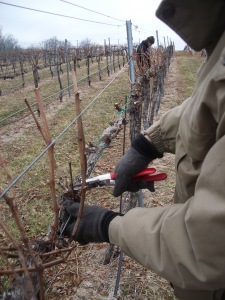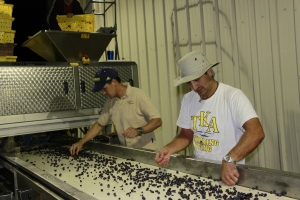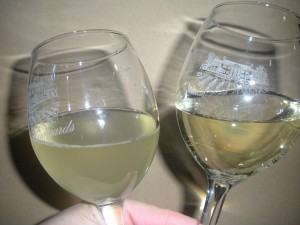Racking the Wine and Stirring the Lees
First and Foremost, a belated Happy New Year to all! I trust and hope that 2014 will turn out to be a very special year filled with happiness and all resolutions being met and exceeded. At Keswick Vineyards, most of the work is centered on the vineyard, ensuring we get all the pruning done before bud break in early April, but the wines and the winery still need some attention. The harvest that was 2013 was challenging to say the least, with a spring frost, a cooler than normal growing season and wildlife of biblical proportions testing the growers and winemakers across the state. I started calling myself Moses since I had 2 of everything on this farm eating the grapes.
 For us, we had to be very careful with how we managed the vineyard and as such decided to bring fruit in a little earlier than hoped, choosing to be a touch more proactive in the winery than we would generally like to be. Since the fruit was not optimally ripe, sorting was critical and many hours were spent on the sorting table, eradicating anything unsatisfactory. We also stayed true to our philosophy of natural fermentation where possible and 50% of our wines were fermented without the addition of commercial yeast, normally we are in the 80-90% range. Although the intention is to ferment wines naturally, under certain conditions of poorer fruit quality, we will add a commercial yeast in order to better control the fermentation and winemaking.
For us, we had to be very careful with how we managed the vineyard and as such decided to bring fruit in a little earlier than hoped, choosing to be a touch more proactive in the winery than we would generally like to be. Since the fruit was not optimally ripe, sorting was critical and many hours were spent on the sorting table, eradicating anything unsatisfactory. We also stayed true to our philosophy of natural fermentation where possible and 50% of our wines were fermented without the addition of commercial yeast, normally we are in the 80-90% range. Although the intention is to ferment wines naturally, under certain conditions of poorer fruit quality, we will add a commercial yeast in order to better control the fermentation and winemaking.
 Fermentations all finished [thankfully] and managing the tannin extraction was critical in ensuring the wines remained balanced, since we were dealing with elevated acid levels and slightly greener flavors. Much is made of yeast choice, fermentation temperatures and other cellar practices but we pay special attention to a rather mundane task of extreme barrel stirring. We believe that barrel stirring really has a softening affect on the astringency of our wines, as well as creating a textural component which for us is also important. Once fermentation is completed, the yeast that converted the sugar into alcohol dies, and settles with time to the bottom of the vessel [either barrel or tank]. At this point a lot of winemakers will employ a racking, whereby most of the wine is removed from the layer of this yeast, essentially clarifying the wine to a certain extent. This process also serves the purpose of introducing oxygen into the wine, ensuring the wine does not become reductive or start smelling like rotten eggs. Others, like myself, employ a vigorous program of stirring each and every barrel of wine to ensure the yeast remains in suspension.
Fermentations all finished [thankfully] and managing the tannin extraction was critical in ensuring the wines remained balanced, since we were dealing with elevated acid levels and slightly greener flavors. Much is made of yeast choice, fermentation temperatures and other cellar practices but we pay special attention to a rather mundane task of extreme barrel stirring. We believe that barrel stirring really has a softening affect on the astringency of our wines, as well as creating a textural component which for us is also important. Once fermentation is completed, the yeast that converted the sugar into alcohol dies, and settles with time to the bottom of the vessel [either barrel or tank]. At this point a lot of winemakers will employ a racking, whereby most of the wine is removed from the layer of this yeast, essentially clarifying the wine to a certain extent. This process also serves the purpose of introducing oxygen into the wine, ensuring the wine does not become reductive or start smelling like rotten eggs. Others, like myself, employ a vigorous program of stirring each and every barrel of wine to ensure the yeast remains in suspension.
The practice of leaving the wine in contact with lees dates back to Roman times, the chemistry behind this phenomenon was not clearly understood, but the positive effects of this practice were noticed. When wine is left in contact with lees, enzymes start to break down the cells, producing mannoproteins and polysaccharides which are released into the wine. Through a metabolic pathway, enzyme substrates [beginning molecules] are turned into some eventual product, in this case the proteins and sugars which in turn lead to fuller bodied wines with better mouthfeel. These products also react with phenolic compounds, reducing the astringency and bitterness of tannins, which in 2013 was a concern due to slightly under ripe fruit.
There is no formula or yardstick by which we measure how often we should employ these stirrings, at the moment we are doing it once a week and then tasting the wine to see if there are any distinguishable changes, either positive or negative. Negative flavors could be the reducing conditions discussed above, resulting in smells reminiscent of rotten eggs, which could reduce further, leading to potentially greater problems in the wine. At this point, a racking would be the simplest form of treatment, discarding the yeast in the vessel. Thankfully, the wines are showing a positive change and are definitely showing a richer texture than when we started so for now we will continue to monitor the wines and keep stirring. The Chardonnays are displaying a creamier texture with an almost brioche like flavor, a great counter play to the acidity and minerality that has become a hallmark of our wines. The reds have fleshed out a little bit, the wines are not as disjointed as they were a few months ago and there is a better balance between the acidity, fruit and tannin structure of the wine. Sometimes the simplest things have the most profound effect on the wine, in this case just stirring the wine constantly.
The bright spot is that after a year with one challenge after the other, the red wines are amazing and we expect to release a Heritage [our Bordeaux estate blend] for the first time since 2007 as well as a varietal Cabernet Sauvignon and Cabernet Franc, both of which look superb. The whites, as always, are consistent and showcase a character that we see each and every year. Still plenty of time to let these wine evolve and develop, but I am liking where they are right now and look forward to seeing where they will end up. Stay tuned Cheers Stephen Barnard Winemaker


